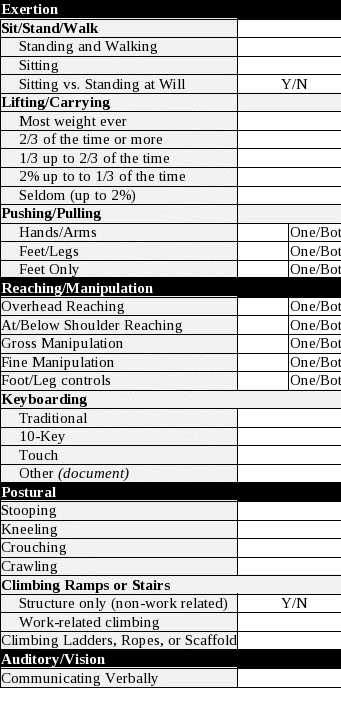Form ORS 4 OJT 1G ORS 4 OJT 1G ORS Job Observation Test Recording Form
Occupational Requirements Survey
Attachment C ORS Job Observation Test Government Collection Tool
ORS Job Observation Test - Public
OMB: 1220-0189


PRINT ADDITIONAL COPIES OF PAGES 2-3, AS NEEDED.



Decision-making |
||
What is the highest level of independent judgment a worker is expected to use to perform the tasks of this occupation?
|
||
|
||
|
||
Pace |
||
Are there faster and slower periods of work?
|
||
|
||
What is the fastest pace performed?
|
||
|
||
|
||
Personal Contacts |
|
|
Regular Contacts: People with whom there is an established working relationship. |
|
|
Other Contacts: People with whom there is no established working relationship. |
||
Select ONLY one (A, B, C, D) for each contact type: |
||
How often does this occupation require verbal interaction (work related) with: |
Regular Contacts |
Other Contacts |
(A) Constantly, every few minutes. |
|
|
(B) More than once per hour, but not constantly. |
||
(C) More than once per day, but not more than once per hour. |
||
(D) No more than once per day; includes never. |
||
|
|
|
Select ONLY one (A, B, C, D, E) for each contact type: |
|
|
What type of work-related interactions does this occupation have with: |
Regular Contacts |
Other Contacts |
(A) Exchanging straightforward, factual information. |
|
|
(B) Coordinating work with others; solving recurring problems with cooperative parties. |
||
(C) Some gentle persuading or soft-selling; discussing. |
||
(D) Influencing; hard-selling; asserting control in situations. |
||
(E) Resolving
controversial or long-rage issues; defending; |
||
ORS Form 4 OJT 1G 1
| File Type | application/vnd.openxmlformats-officedocument.wordprocessingml.document |
| File Title | OMB Pre-Production ORS Collection Form, Government |
| Author | [email protected] |
| File Modified | 0000-00-00 |
| File Created | 2021-01-21 |
© 2026 OMB.report | Privacy Policy

